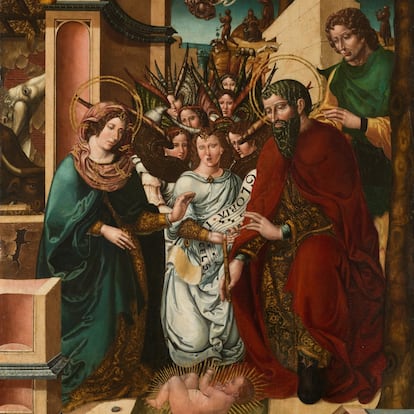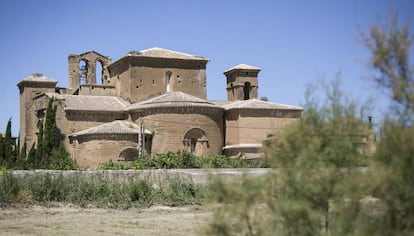The Government of Aragon will reclaim the Nativity of Sijena, which is in the Prado, if it is proven that it was removed illegally.


Aragon will demand the Nativity from Sijena from the Prado Museum if it is proven that it left the monastery illegally after the Civil War. This was stated by the Vice President of Aragon, Mar Vaquero, in statements to the regional press on Wednesday.
The work, a Gothic painting that formed part of the monastery's main altarpiece, has been on display at the Prado since 2003. Juan José Nieto, researcher, historian and expert in the case of the Sijena paintings by the Huesca City Council, has suggested the possibility that, after the Civil War, this Nativity scene was illegally removed from the monastery, which had already been declared a national monument in 1923. Nieto bases his work on the documentation provided by the National Art Museum of Catalonia (MNAC) on the Sijena paintings, which it exhibits in one of its galleries and which are the subject of a legal battle that concluded last May with a ruling by the Supreme Court. The court ruled in favor of the Government of Aragon , dismissed the appeals of the Generalitat and the MNAC, and ordered that the 13th-century Romanesque frescoes be returned to their original location. The Supreme Court argued that the Catalan museum has not provided any "contract document" legitimizing this "possession" and that its custody is in the form of a "deposit," since "it has not possessed the paintings as an owner, as they were removed."
The Nativity was also part of the collection of Gothic paintings removed from Sijena, and is now on display at the Prado. In 2003, the State acquired it at auction from the Sala Alcalá (Madrid) for 90,000 euros, according to an official document shared by the art gallery on social media. The piece was sold by the San Juan nuns; the exact date of its departure from Sijena is unknown.

Following the statements by the Vice President of Aragon, the Prado Museum points out that "if there are revelations that indicate the illegality of the removal of the work from Sijena, we will proceed according to the decisions of the institutions," and insists that the Prado is "against illegality and will rectify it if proven." In 2023, the Prado Museum prepared a report with expert Arturo Colorad on the works in its collections that originated from seizures, and determined that there were 70 pieces involved. The Sijena painting was not among them. "The works must be in the possession of their rightful owners, and this necessarily opens a period of study," the museum insists.
Until now, the history of The Nativity referred to a 1926 article by art historian August Mayer, in which he claimed that the work was purchased by antique dealer A.L. Nicholson, who put it up for sale in London. In 1944, collector Arnold Seligmann included the work in the Great Exhibition of World-Famous Paintings at the Galerías Ordáz in Mexico City. After that sale, it appeared in Madrid. Historian Nieto has now explained to the media that "the photographs show that the painting was in the monastery's chapter house in 1936 because it can be seen next to some walls already scraped by [Josep] Gudiol, and that, therefore, it must be considered a war loot, since it could not be sold because Sijena was already a national monument." His claim has been refuted on social media by historians Albert Velasco and Marisancho Menjón, former director general of Cultural Heritage for the Government of Aragon. Menjón asserted that the "tablet couldn't have been in the Sijena chapter house in 1936; if it had been, it would have burned. You're confusing the dates of the photos."
What you must have seen are photos from before the fire. There are several, dating back to around 1919, like this one posted by Ricardo del Arco at that time: pic.twitter.com/T7eQ7ZBxQg
— Mari Menjón (@Inde) August 6, 2025
This Wednesday, the Vice President of Aragon emphasized that the doubts about the date of Sijena's removal from La Natividad stem from information provided by technicians, but noted that if this is confirmed, a claim will be filed, as has occurred with the other works involved in the lengthy process of claims and litigation with the MNAC. "We would proceed in the same way, by filing a claim," she emphasized.
The Prado piece shows the Holy Family with the child lying on the ground and is attributed to the master of Sijena, who resided in the monastery at the time this painting was made, according to a notarial document.

She is a cultural journalist. She holds a degree in History and Politics from the University of Kent and was awarded a scholarship to the Graduate School of Journalism at Columbia University in New York. Her work, with a special focus on the literary world, has also appeared in magazines such as The Paris Review and The Reading Room Journal.
EL PAÍS


%3Aformat(jpg)%3Aquality(99)%3Awatermark(f.elconfidencial.com%2Ffile%2Fbae%2Feea%2Ffde%2Fbaeeeafde1b3229287b0c008f7602058.png%2C0%2C275%2C1)%2Ff.elconfidencial.com%2Foriginal%2F779%2F2c7%2F1d5%2F7792c71d597c02f4d81304dc3f12af89.jpg&w=1280&q=100)
